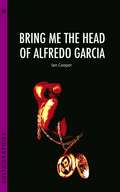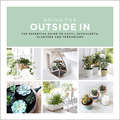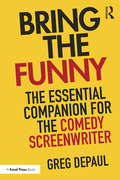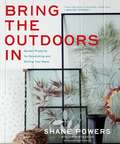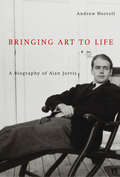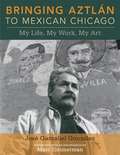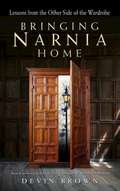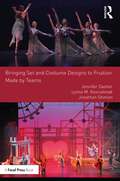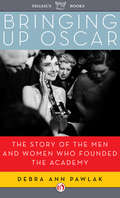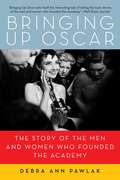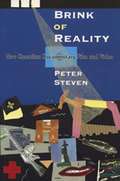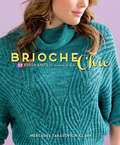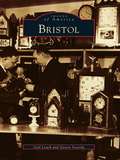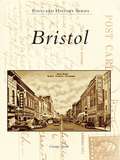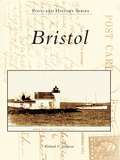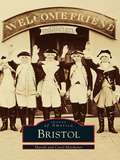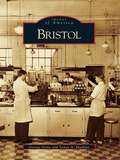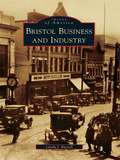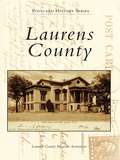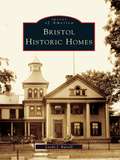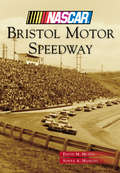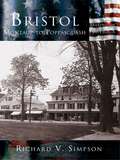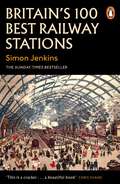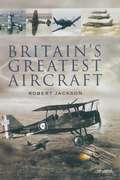- Table View
- List View
Bring Me the Head of Alfredo Garcia
by Ian CooperIn 1974, The Wall Street Journal called this movie "grotesque, sadistic, irrational, obscene, incompetent," while New York Magazine declared it "a catastrophe." Upon its initial release, Sam Peckinpah's notorious work took a critical and commercial nosedive, but in later years, the work was heralded as a demented masterpiece--a violent, hallucinatory autobiography and a brilliant example of "pure Peckinpah." This study revisits the making of this controversial film, as well as its original reception and subsequent reassessment. It reads the project as an auteur work, a genre film, a confession, and a bizarre self-parody.
Bring Me the Head of Alfredo Garcia (Cultographies)
by Ian CooperIn 1974, The Wall Street Journal called this movie "grotesque, sadistic, irrational, obscene, incompetent," while New York Magazine declared it "a catastrophe." Upon its initial release, Sam Peckinpah´s notorious work took a critical and commercial nosedive, but in later years, the work was heralded as a demented masterpiece--a violent, hallucinatory autobiography and a brilliant example of "pure Peckinpah." This study revisits the making of this controversial film, as well as its original reception and subsequent reassessment. It reads the project as an auteur work, a genre film, a confession, and a bizarre self-parody.
Bring The Outside In: The Essential Guide to Cacti, Succulents, Planters and Terrariums
by Val Bradley_____________"Everything you need to know about keeping plants in your house... lovely pictures, tips, tricks... I love it." (Zoe Sugg a.k.a Zoella)Love plants, but short on outdoor space? Keen to fill your home with greenery but don't know where to start? Or perhaps you've been labelled a house-plant serial killer? Then this is the book for you.With stunning photography and expert step-by-step tips, Bring The Outside In reveals everything you need to know to help your plants thrive, from dramatic statement foliage and miniature citrus trees to table-top terrariums and hanging planters. With chapters on orchids, cacti, herb gardens and chilli plants, your home will be flourishing in no time.
Bring the Funny: The Essential Companion for the Comedy Screenwriter
by Greg DePaulA sharp, funny book about comedy screenwriting from a successful screenwriter that uses recent – as in this century – movies you've actually seen as examples. Greg DePaul (Screenwriter, Bride Wars, Saving Silverman) has sold scripts to Miramax, Fox, Disney, New Line, Sony, MGM and Village Roadshow. He's worked with comedy stars like Jack Black, Kate Hudson, Jason Biggs and Amanda Peet. Now Greg takes everything he knows about writing comedy and breaking into the biz, tosses it into a blender and serves up this tasty, fat-free smoothie of a book that’s easy to read, brutally honest, and straight from the heart ... of Hollywood. Bring the Funny is chock full o' tricks, strategies and insider terms used by successful comedy screenwriters, including: Comic Justice Wrylies Genre-Bending Shadow Characters The BDR's The Two-Hander The Conceit Comedic Escalation Gapping A.I.C. Fish Outta Water The Idea Factory Really Important Comedy Screenwriting Rules Number 99 and 100 If you're looking to write funnier and better screenplays, you want this book. But if you're ready to pack up your car, drive out to L.A., and dive into a career as a comedy screenwriter, you need this book. Now. Buy it, jam it into your pocket, and hit the gas. Greg's got your back.
Bring the Outdoors In
by Jennifer Cegielski Shane PowersNothing enlivens a room like a touch of nature. Taking the terrarium trend to the next level, this stunning guide will inspire crafters, garden lovers, and décor fans to turn flowers, leaves, and branches into striking, organic décor. Acclaimed designer and stylist Shane Powers presents 20 simple yet arresting projects for bringing natural tranquility to any space. Suited for garden enthusiasts and black thumbs alike, the projects use a range of live and dried plant materials to create colorful dried floral garlands, eye-catching willow wreaths, intriguing water gardens, and timeless succulent landscapes. With step-by-step instructions, styling and container ideas, helpful resources, and gorgeous photography, Bring the Outdoors In offers countless ways to welcome the natural world into any space.
Bringing Art to Life: A Biography of Alan Jarvis
by Andrew HorrallOnly thirty-nine when he took over the National Gallery in 1955, Jarvis already had an extraordinary record of achievement and social mobility at home and in England: he had trained with Canada's greatest artists, won a Rhodes scholarship, lunched at the Algonquin Round Table in New York, managed an aircraft factory, written a bestseller, produced films, run a slum settlement, and moved in a London social circle that included Noël Coward and Vivien Leigh. As head of the National Gallery, Jarvis was a provocative public educator, advocating his idea of "a museum without walls" in countless public appearances. Instrumental in bringing modern art to the National Gallery, he shook artists and the art-minded public out of a period of national complacency. This first detailed account of the controversy surrounding his time at the gallery provides an important context for the ongoing and contested role of publicly supported arts and art institutions in this country.
Bringing Aztlan to Mexican Chicago: My Life, My Work, My Art
by Marc Zimmerman Jose Gamaliel GonzalezBringing Aztlán to Mexican Chicago is the autobiography of Jóse Gamaliel González, an impassioned artist willing to risk all for the empowerment of his marginalized and oppressed community. Through recollections emerging in a series of interviews conducted over a period of six years by his friend Marc Zimmerman, González looks back on his life and his role in developing Mexican, Chicano, and Latino art as a fundamental dimension of the city he came to call home. Born near Monterey, Mexico, and raised in a steel mill town in northwest Indiana, González studied art at the School of the Art Institute of Chicago and the University of Notre Dame. Settling in Chicago, he founded two major art groups: El Movimiento Artístico Chicano (MARCH) in the 1970s and Mi Raza Arts Consortium (MIRA) in the 1980s. With numerous illustrations, this book portrays González's all-but-forgotten community advocacy, his commitments and conflicts, and his long struggle to bring quality arts programming to the city. By turns dramatic and humorous, his narrative also covers his bouts of illness, his relationships with other artists and arts promoters, and his place within city and barrio politics.
Bringing Narnia Home: Lessons from the Other Side of the Wardrobe
by Devin BrownThe wisdom of C. S. Lewis comes in a form that is deeply moving as well as great fun and high adventure. Noted Lewis scholar and popular speaker Devin Brown reveals the lessons woven throughout this endearing text. Bringing Narnia Home presents Lewis’s timeless message for the Narnian in each of us. Imagine opening a book and finding chapters like these:Of Mice and Minotaurs: Actions We See as Small and Insignificant Can Be More Important than We Realize Despite What White Witches, Tisrocs, and Other Tyrants ThinkNarnia Would Not Be Narnia if It Was All Badgers: It Takes a Village (One with Giants, Dwarfs, and Everyone in Between) to Make a CommunityAdventures Can Begin in the Most Unlikely Places (Something to Keep in Mind the Next Time You Find Yourself in an Unlikely Place)A wise, winsome, and whimsical look at the important values and lessons the Narnia series teaches that actually provide the groundwork for a profound and meaningful life.
Bringing Set and Costume Designs to Fruition: Made by Teams
by Jennifer Dasher Lynne M. Koscielniak Jonathan ShimonBringing Set and Costume Designs to Fruition: Made by Teams dives into the collaborative working relationships between set and costume designers with their technical counterparts throughout the theatrical production process, from concept to execution. Set and costume designers render environments and characters for a wide array of performative events; skilled artisans and technologists bring these visions to life. This book explores the dynamic between those who decide what the set and costumes should look like and those who make them work, including scene designers, costume designers, scene shops, and costume shops. The book discusses how to identify resources, ask the right questions, and engage in healthy collaborations. Following these fundamentals are practical activities and interviews with industry professionals that demonstrate how these skills can be applied to a broad range of productions and other avenues for creative design and production. Bringing Set and Costume Designs to Fruition is written for emerging professionals in set and costume design, as well as students in courses across a theatre degree program, including stagecraft, costume construction, scene design, and introduction to theatrical design and production.
Bringing Up Oscar
by Debra Ann PawlakThe untold story of the innovative pioneers who helped make movies the preeminent art form of the twentieth century The founders of the now infamous Academy were a motley crew as individuals, but when they first converged in Hollywood, then just a small town with dirt roads, sparks flew and fueled a common dream: to bring artistic validity to their beloved new medium. Who were these movers and shakers who would change movies forever? And what about Oscar, their famous son? He is fast approaching his 100th birthday, and is still the undisputed king of Hollywood. Yet with such dynamic parents, what else could we expect?
Bringing Up Oscar: The Story of the Men and Women Who Founded the Academy
by Debra Ann PawlakThe untold story of the innovative pioneers who helped make movies the preeminent art form of the twentieth century. The founders of the now infamous Academy were a motley crew as individuals, but when they first converged in Hollywood, then just a small town with dirt roads, sparks flew and fueled a common dream: to bring artistic validity to their beloved new medium. Who were these movers and shakers who would change movies forever? And what about Oscar, their famous son? He is fast approaching his hundredth birthday and is still the undisputed king of Hollywood. Yet with such dynamic parents, what else could we expect?
Brink of Reality: New Canadian Documentary Film and Video
by Peter StevenIn Brink of Reality, Peter Steven examines the convergence of video-art and social-issue documentary, from the 1940s to the present. No other book has explored contemporary Canadian documentary so thoroughly, or provided as broad a view of the state of the art in the 1990s.
Brioche Chic: 22 Fresh Knits for Women & Men
by Mercedes Tarasovich-ClarkA modern take on brioche stitch with gorgeous wearable garments and accessories that knitters will love. Knitters will create striking colorwork and beautiful faux cable designs with Brioche Chic. Author Mercedes Tarasovich-Clark offers a solid introduction to brioche and a collection of 22 garments and accessories for women and men, including hats, scarves, cowls, mittens, pullovers, vests, and cardigans. Striking designs that are not overwhelming or full of complicated techniques will reel in readers to this fun style of knitting. Starting with the basics, Brioche Chic offers mini collections of garments revolving around a specific set of techniques. Basic brioche starts the first section, as Mercedes shows how the basic rib pattern can be adapted to simple motifs, lace, and various textures. Later, she offers more complex designs such as cables and various types of two-color brioche. Some of the featured garments are all-over brioche, while others integrate brioche with stockinette stitch for more streamlined, flattering designs.
Bristol
by Steven Vastola Gail LeachBristol was originally a tightly held and uninhabited portion of Farmington and was known in its early days as the West Woods. Settlers did not arrive until the 1720s and, after building their small community, they sought and received status as the New Cambridge Parish in 1742. Their numbers continued to grow and, by 1785, the community joined neighboring West Britain Parish in separating from Farmington and becoming the town of Bristol. Bristol tells the story of the people, places, and events that transformed this small agricultural hamlet into a true industrial city. The waters of the Pequabuck River brought industry, which soon surpassed farming as the residents' primary livelihood. Bristol became the source of many important products-clocks, springs, silverware, coaster brakes, doorbells, automobiles, roller bearings, and fishing rods, to name a few. In following this evolution, Bristol highlights the residents and workers, their homes and places of business, their entertainment and modes of transportation.
Bristol
by George StoneIn 1852, Joseph R. Anderson purchased 100 acres on the Virginia-Tennessee border with the intent of building a town in the foothills of the Appalachian Mountains. Four years later, Bristol was incorporated, and it celebrated its 150th birthday in 2006. Taking its name from the English city, Bristol is also known as the Twin City because of its two distinct towns with two separate governments--one in Virginia and the other in Tennessee. Postcard History Series: Bristol portrays the city from the late 1800s through its growth during the 20th century and preserves its rich heritage in vintage postcards.
Bristol
by Richard V. SimpsonBristol, a shire town in the smallest county in the smallest state, is nestled between the Narragansett and Mount Hope Bays. Most of the town is surrounded by water, and its history lies therein. Bristol is ever changing, yet it manages to retain a small hometown character. This nostalgic postcard history of Bristol leads readers down dusty, mid-19th-century streets and into the bustling mid-1950s historic center. Today, people sail leisurely into Bristol's snug harbor, dock at the many public landings, and dine on the waterfront. Other visitors stroll down tree-lined streets, take in the many beautiful seascapes, or marvel at the aristocratic 18th-century homes built by wealthy merchants, slavers, and privateers.
Bristol (Images of America)
by Harold Mitchener Carol MitchenerBristol traces its roots to a grant obtained by Samuel Clift in 1681, William Penn's establishment of an estate one year later, and to its location along prime transportation routes. Situated below the fall line of the river and along the main route for land travel, Bristol afforded direct access between Philadelphia and New York City. As more people and businesses started to call the new settlement home, Bristol began to find its place in history. Bristol is a pictorial journey to the roots of one of America's oldest towns. The book beautifully illustrates its development from a countryside encampment, to the government seat of Bucks County, to the setting of major industry. The growth of Bristol is portrayed through the development of its municipal services, organizations, and entertainment facilities. Furthermore, these images attest to the way Bristol responded to conflict, from the Civil War to World War II, by providing ships, airplanes, and its own heroes. A remarkable collection of images from theMargaret R. Grundy Memorial Library and other sourcestells the story of a truly unique place.
Bristol (Images of America)
by Sonya A. Haskins George StoneImages of America: Bristol celebrates the history of the town known as "A Good Place to Live." Joseph A. Anderson bought land on the Virginia-Tennessee border from his father-in-law, Rev. James King, and founded Bristol in 1852. Just four years later, the Virginia and Tennessee Railroad came to Bristol, and the town became a major trading center of the Appalachian region. During the Civil War, Bristol was a vital railway link between the North and the South, and it later became known as the birthplace of country music. Readers are sure to enjoy viewing over 200 vintage photographs of the train station, the Carter Family, the King family, Virginia Intermont College, and King College, as well as homes and people from all walks of life. The S. E. Massengill drug manufacturing company shown on the cover is among the highlighted industries.
Bristol Business and Industry
by Lynda J. RussellBristol was incorporated in 1785 and quickly became recognized as a clock-manufacturing center and home of the E. Ingraham Company's "dollar watch." The town grew with the many immigrant workers who arrived to work for local knitting mills, spring companies, and brass manufacturers. By the 1890s, the strong growth of the town brought an influx of people with different skills who established the Bristol Press, banks, local neighborhood shops and markets, and service industries. In 1920, Bristol Nurseries created new varieties of chrysanthemums that eventually made Bristol known as the "Mum City." Redevelopment in the 1960s brought the new Bristol Plaza and changes on Farmington Avenue. In 1979, ESPN started its first broadcast in its new home on Middle Street. With the completion of the new Route 72, Bristol will today continue to offer new opportunities for business and industry to grow.
Bristol Dragway (Images of Sports)
by David M. Mcgee Kenny BernsteinBristol Dragway was carved into an East Tennesseemountainside in 1965. In the more than four decadessince, the track known as "Thunder Valley" has carved its niche as a world-class facility in professional drag racing. Located adjacent to Bristol Motor Speedway, the dragway's well-earned nickname stems from the unique acoustic experience fans get when the power of unlimited racing engines echoes off the nearby hillsides. Bristol Dragway retraces the track's early history, its role in shaping the sport, and its return to prominence after an $18 million renovation in the late 1990s. The book features images of drag racing's greatest stars and chronicles decades of the sport's most memorable moments.
Bristol Historic Homes
by Lynda J. RussellBristol, originally known as West Woods, formed later than other Colonial towns. Bristol's mother town of Farmington was settled in 1640 and became a town in 1645, but pioneers did not lay out the remote and unpopulated section of Farmington until 1721. The Jerome, Matthews, and Lewis families created the New Cambridge Parish in 1742, and it was this parish that separated from Farmington and finally formed the town of Bristol in 1785. In Bristol Historic Homes, readers will meet these families and other important figures, such as Ebenezer Barns. Barns built the first permanent home in 1728, and this structure later became a tavern and community center. Through wonderfully preserved vintage photographs, this volume shows how an agricultural community grew and prospered as a variety of skilled tradesmen brought hard work and vision to this beautiful area.
Bristol Motor Speedway
by David M. Mcgee Sonya HaskinsWhen Bristol's race track opened in 1961, tickets were often given away to fill the 18,000 seats. Over the years, Bristol Motor Speedway has grown to 160,000 seats and legendary status among race fans. There is a fascination with the unforgettable moments that take place at the track, including rivalries that are hard to miss when fans can watch all the action around the half-mile track no matter where they are seated.
Bristol: Montaup to Poppasquash
by Richard V. SimpsonThe picturesque images and steadfast spirit of small-town America thrive within Bristol. One need only to look along its tree-lined streets and centuries-old waterfront and into its historic homes and buildings to see the romance of Rhode Island's past mingling with its present. Heritage and tradition, especially its long-running celebrations of the Fourth of July, are essential in understanding the character and identity of this little town on the bay.Bristol: Montaup to Poppasquash takes readers on a unique journey through the community's past, beginning with the voyages of early Norse explorers and detailing major events that shaped the town's history, including the King Philip's War, the Revolutionary War, and a variety of other military conflicts that took local men and women away from their homes. Not only evoking memories of yesteryear, this compelling illustrated history explores the evolving personality of Bristol over the passing decades, from its days as a small fishing village and a haven for privateers to its present status as a premier boat-building center.
Britain's 100 Best Railway Stations
by Simon JenkinsDiscover the architectural gems that are Britain's 100 Best Railway Stations in this Sunday Times top 10 bestseller'This is a cracker . . . a beautiful book' Chris EvansIt is the scene for our hopeful beginnings and our intended ends, and the timeless experiences of coming and going, meeting, greeting and parting. It is an institution with its own rituals and priests, and a long-neglected aspect of Britain's architecture. And yet so little do we look at the railway station.Simon Jenkins has travelled the length and breadth of Great Britain, from Waterloo to Wemyss Bay, Betws-y-Coed to Beverley, to select his hundred best railway stations. Blending his usual insight and authority with his personal reflections and experiences - including his founding the Railway Heritage Trust - the foremost expert on our national heritage deftly reveals the history, geography, design and significance of each of these glories. Beautifully illustrated with colour photographs throughout, this joyous exploration of our social history shows the station's role in the national imagination; champions the engineers, architects and rival companies that made them possible; and tells the story behind the triumphs and follies of these very British creations. These are the marvellous, often undersung places that link our nation, celebrated like never before.'However spectacular the book's photographs, it's the author's prowess as a phrase-maker that keeps you turning the pages' The Times'An uplifting exploration of our social history' Guardian
Britain's Greatest Aircraft
by Robert JacksonDuring the last century the British aircraft industry created and produced many outstanding aeroplanes. These aircraft were world leaders in advanced technology, utilizing inventions by British engineers and scientists such as radar, the jet engine, the ejector seat and vertical take-off and landing. This book describes the design-history, development and operational careers of twenty-two legendary military and civil aeroplanes. Each one has played a significant part in aviation history.Sopwith Camel, SE.5, Bristol F2B Fighter and the Airco DH4 were all great successes in the relatively early days of flight. In the thirties the Bristol Bulldog fighter was an outstanding export success and the Short 'C' Class flying boat, later to become the Sunderland of World War II fame, pioneered the long-distance routes to the Empire. The pugnacious foreign policy of Hitler's Reich rung sudden alarm bells, rapid advances in fighting aircraft for the RAF became a premium objective. The brilliant Geodic construction of the Vickers Wellington bomber helped it survive terrible punishment throughout World War II, both the Hawker Hurricane and the Supermarine Spitfire saved England from invasion and the Bristol Beaufighter, de Havilland Mosquito and Avro Lancaster took the war to enemy soil. The Gloster Meteor became the word's first operational jet fighter and the English Electric Canberra became the RAF's first jet bomber and was manufactured under licence in the USA as the Martin B-57. In post-war years the Vickers Viscount became the world's first turboprop airliner and eventually became Britain's best selling commercial aircraft, whilst the de Havilland Comet became the world's first jet airliner. Despite Britain's recessionary years in the 50s and early 60s, military success came with the beautiful Hawker Hunter, the super-sonic Fairey Delta experimental aircraft that broke the World Air Speed Record and the Vickers Valiant that pioneered the operational techniques to deliver Britain's nuclear deterrent. Later, there followed the Mach 2 English Electric Lightning and the ill-fated TSR-2, the cancellation of which is still regarded as one of the greatest mistakes ever made in British aviation history. Finally, the Harrier, the world's first vertical take-off and landing jet fighter that is still in service and now only being built in the USA.Finally the Harrier, the world's first vertical take-off and landing jet fighter, still in service and now being further developed in the USA.
